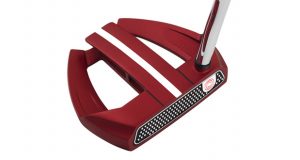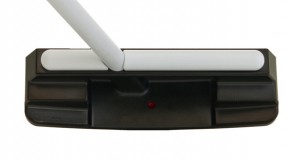As a renowned golf instructor and a leading authority on the short game, Dave Pelz probably needs no introduction, but we’ll give him one anyway. Pelz spent 14 years as a NASA scientist before dedicating himself full-time to a career in golf research and development. He is the founder of the Dave Pelz Scoring Game School, and 10 of his professional students have won a total of 19 major championships. He is a New York Times best-selling author of several books, including “Putt Like the Pros” and “Dave Pelz’s Putting Bible.”
Another lesser-known fact about Pelz is that he is the inventor of the 2-Ball alignment concept, which he licensed to Odyssey Golf, and which has subsequently become one of the most influential and successful putter designs ever created. Early last year, he formally joined the Odyssey staff as a brand ambassador.
PutterZone.com is honored to share the following exclusive interview with Mr. Pelz, in which we delve into his approach to putting, his thoughts on the best putters on the professional tours, and much more.
What is the number one fatal putting flaw that you see with recreational golfers?
If there was one generic description of the worst flaw, it would be that the poor-putting amateur golfer uses his hands too much in the stroke. He uses his hands to close the blade before impact. He uses his hands to cup or hinge to supply power, and he uses his hands to guide the rotation of the putter. Golfers just tend to intuitively and instinctively use their hands to control their putter.
If you think about it, you use the small muscles in of your hands, wrists and fingers all the time. You write with them, you pinch things and squeeze things and tear things. That’s the biggest problem we face—just getting those motions out of the putting stroke.
I have often said in my schools that if I could make one change in golfers, I would have them place their hands into some kind of cement mitt, where they could hold and swing their putter, and they could stroke putts, but they couldn’t manipulate the putter face during that stroke motion with their fingers, hands or wrists. That would make them better putters.
Do you have any simple suggestions for fixing this problem?
In our schools, for the last 20 years, we’ve been using long putters that you anchor into your chin or your chest, really long putters. You anchor the putter against your body, then you place your hands on it, and of course you cannot hinge your wrists, and once you take a very light grip and motion, you tend to not try to control the putter face, you just let the putter swing back and through. That’s the drill we suggest you do before you putt normally, if you have a normal-length putter. It’s a drill that you have to do a lot of times before you start doing it properly, before it grooves into a proper stroke memory. But it does help.
(Editor’s note: Pelz adds that if you don’t have access to a long putter or extension, you can anchor and stroke a long broom handle or similar stick to help you understand the sensation of keeping your hands quiet).
In terms of overall mechanics and approach, which golfer (or golfers) on the professional circuits best exemplifies the fundamentals that you teach—and can you briefly explain these fundamentals?
I think maybe the best mechanical stroke today would actually be on the Champions Tour, the Boss of the Moss—Loren Roberts. He’s got a beautiful pendulum stroke, he doesn’t hinge his wrists, and he doesn’t rotate his forearms, so the face stays very square through the impact zone. Approximately six inches before impact and a foot after impact, the putter blade is exactly perpendicular to the line, which means he can deliver a square strike to the putt.
Loren Roberts best exemplifies what I would like golfers to do. He does not manipulate the putter at all through impact. The putter blade stays square through the impact zone. He does not add energy or hit the putt in any way. He has a pure stroke motion.
There are a number of other good ones. Brad Faxon has a great putting stroke, Ben Crenshaw, Mickelson, Tiger…Of the young breed, I think that Anthony Kim has maybe the best stroke, at least on short putts. He’s not as good of a lag putter as he should be, he will learn that. But right now he’s just absolutely wonderful inside of six feet, one of the best. I’ll tell you another really good guy at short putting, he keeps his putter very square through impact, and that’s Hunter Mahan. He’s done very well recently with keeping his blade square through impact.
There are a lot of them out there that bring the putter thorough impact very squarely, and that’s basically what I teach. I try to get golfers to do whatever—stand a different way, or perhaps change their grip, but as soon as I get them to stop using their finger muscles, hand muscles and wrist muscles, then I try to get them to stand in a position where their hands are below their shoulders, and they can just let the putter swing back and through in a pendulum motion from their shoulders.
In the old days, the greens were so slow, most of the guys had to hit putts to get them to the hole. Billy Casper, Gary Player and those guys that really hit their putts, their strokes don’t last long, they don’t work very well on really fast greens. The best putter of all time according to my measurements was George Archer. He made a higher percentage of putts from each distance than anybody else I ever measured. He putted better than Nicklaus, whom he competed against his whole life. He putted better than Gene Littler, Bob Charles and Tom Watson, to name a few.
And Tom is another unique story. Back then Tom Watson reminded me of what I just described about Anthony Kim—a great short putt putter, he’s actually the only player that I measured who made a higher percentage of putts inside of six feet than George Archer, but he was not a very good lag putter. Then when he got a little older, his short putting degraded dramatically when he started using his hands. But when he was young, he did not use his hands and he was wonderful inside of six feet.
What are your feelings on the straight-back-straight-through putting stroke vs. the arcing stroke?
The most dependable, the most reliable, and the simplest is the straight-back and straight-through stroke, so I like it a lot. You have to stand in the proper posture in order to make that a natural swinging motion, which is what I would like. But it’s more important to me that you do not manipulate your hands, that your wrist angles don’t change, and your forearm rotation must be zero to have a good putting stroke.
When you stand over your putter, you can drop your hands vertical from your shoulder sockets, but if they are outside of that vertical position, then your arms must rotate around your body, and that dictates that you must have an inside-to-inside arcing stroke. But that doesn’t mean you have to rotate your forearms or break your wrists. It just means that the putter is going to swing slightly inside on the back swing, and slightly inside on the follow through. That’s not a problem for me. It’s not quite as simple a motion as straight-back and straight-through, and I’d rather have that. But many more people putt that way than straight-back and straight-through. A minority of putters stand in a posture that allows them to putt straight-back and straight-through. But I try to get people there in our schools, and I see if it feels natural, and if it feels okay, I leave it there because they putt better that way. I myself, in my own stroke, stand so that I can take it straight-back and straight-through.
The rotation of a putter blade through impact does nothing good for a putt, and it does a lot of bad if you hit the ball early or late in your swing, as that means your face will be open or closed. It’s like trying to be somewhere on time. You’ve probably never been on time your whole life—you’ve either been minute or two early or late, or a second, or a millisecond, or a nanosecond. You’ve never been exactly on time. It’s the same thing in putting. If you have your putter blade exactly square to where you want the ball to go, that’s when you hit the putts perfectly. But it’s hard to do that unless the putter is there swinging squarely through impact over a long period of time, because timing is very important in golf. If you’re rotating your putter blade, then it’s open a lot, open a little, perfect, closed a little bit, and closed a lot. So it’s only perfect at one instant in time. I like to extend that time period around impact. I like the putters who bring them square through impact and keep them square.

Can you elaborate on your affiliation with Odyssey and your role in the development of the Odyssey 2-Ball putter?
For many years, many companies have asked me to endorse putters. I’ve never endorsed a putter line for any company prior to Odyssey because I didn’t like a lot of the putters, and I didn’t want to attach my endorsement to a putter line that was just a fad and that was going to come and go. My intent is not to sell putters, it’s to help people putt better. It’s one of my fundamental goals in life, to help golfers score better, make more putts and enjoy the game more.
Over they years I’ve watched Odyssey, they’ve done a lot of research. They actually developed a line of putters based on one of my patents. They came to me and asked if they could license the 2-Ball and 3-Ball from me. I said, ‘Well, let me see what you’re doing with it.’ I saw their research, and it was very good, so I licensed that patent to them.
Since then, they’ve come out with the Backstryke, and I really like that. I really like the 2-Ball putters that they’ve made. And the D.A.R.T. putters are again based on alignment features that help golfers make more putts, and their entire putter line is based on research and testing. I agreed over a year ago to be the brand ambassador for Odyssey because with their research capability, and their focus on helping golfers putt better, it aligned itself with what I’m doing in my schools and the way I teach. I love the D.A.R.T. and the Backstryke, and I personally putt with a 2-Ball Backstryke putter (pictured above). I think it’s the best putter I’ve ever seen.
Thank you, Dave Pelz!
 PutterZone – Best Putter Reviews
PutterZone – Best Putter Reviews





Dave puts into words what I've always thought about an arc stroke: It is fragile and highly timing dependent. Unless you practice like a pro for many hours/day, you'll be forever shaky. Is it sorta natural? Yeah, but it does not naturally produce predictably precise directional contact with the golf ball.
Those arc boards are designed by someone who is unlikely to have a body, height, and arms like yours and can impart their own basket of problems.
Totally agree with straight back straight through (SBST) putting method. Have been practicing this way for two years now.
What was missed in this conversation/article is that SBST is not a natural method for long puts (say > 40 ft). This is because your body and putter face naturally arc (like a full swing) on long puts.
What do I do with my left elbow?